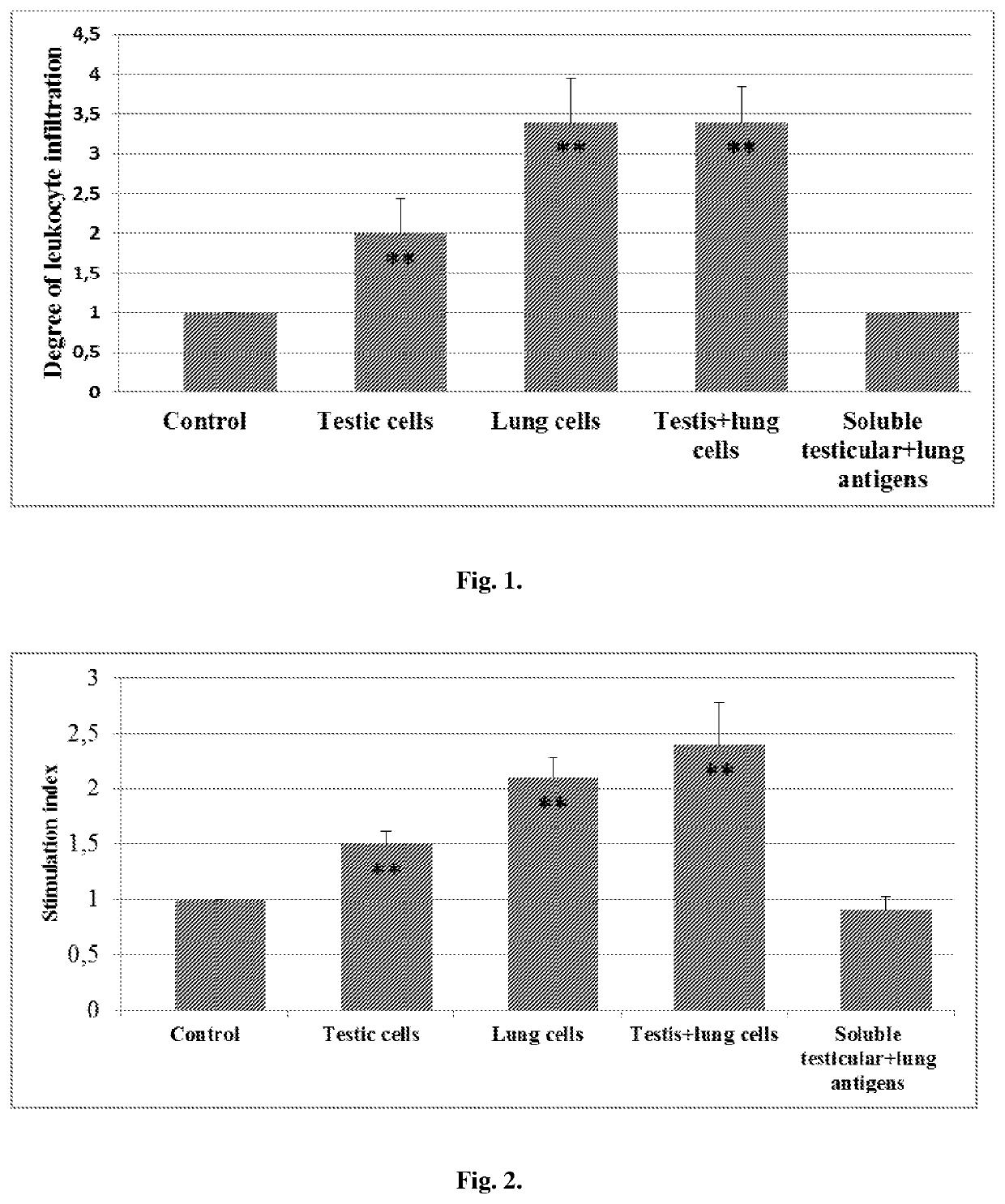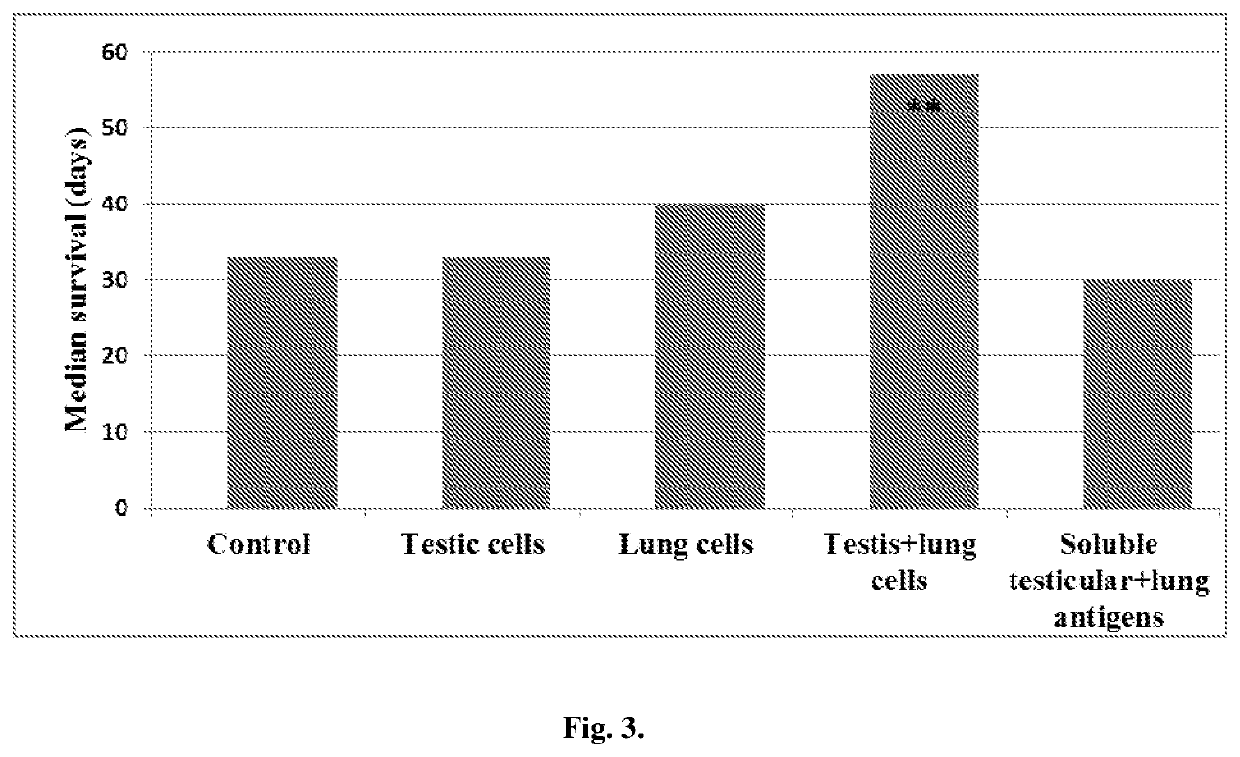Xenogenic normal tissue-derived vaccines for breaking the immune tolerance to tumor-associated, antigens
a normal tissue and vaccine technology, applied in the field of xenogenic polyantigenic antitumor vaccines, can solve the problems of high immunogenic potential, limited therapeutic success of immunizations with unmodified homologous (autological or allogeneic) tumor cells in cancer patients, and no radical treatment of chemotherapy
- Summary
- Abstract
- Description
- Claims
- Application Information
AI Technical Summary
Benefits of technology
Problems solved by technology
Method used
Image
Examples
example 1
Vaccinations with Xenogenic Tissue-Derived Cells Stimulate Infiltration of the Tumor with Leukocytes
[0034]The inflammatory response at the tumor margin was evaluated by enumerating mononuclear and granulocytic cells over ten high-powered (40× objective) fields. As can be seen in FIG. 1, xenovaccinations of tumor-bearing mice with either testis or lung cells, as well as a mixture of those cells induced a marked leukocyte infiltration of the tumor, whereas vaccinations with soluble xenogenic antigens have no such an effect. The detected inflammatory responses were composed of eosinophils (nearly 20%), neutrophils (40%), lymphocytes (30%) and macrophages (10%). The marked tumor-associated tissue eosinophilia at the tumor margins of cell-vaccinated mice distinguishes those inflammatory responses from that observed in the tumors of control mice. A tumor-associated eosinophilic infiltrate has been shown to be a favorable prognostic indicator in colorectal carcinoma and early esophageal sq...
example 2
Vaccinations with Xenogenic Tissue-Derived Cells Induce Immune Reactivity to Tumor Cells.
[0035]The present example demonstrates that immunization with xenogenic tissue-derived cells is able to induce antitumor T-reactivity evidenced by producing interleukin-2 (IL-2). IL-2 is well known to be a pivotal mediator in the mechanism of generating the long-lasting adaptive immunity. As shown in FIG. 2, soluble xenogenic (testicular plus lung) antigens failed to induce T-cell reactivity to LLC antigens in tumor-bearing mice. Adjuvants appear to be required to render xenogenic soluble antigens capable of inducing immune responses with a notable efficiency. In contrast to the soluble antigens, both testis and lung cells were able to induce detectable antitumor reactivity (p<0.05 compared to control). Noteworthy that the combined vaccinations with testis and lung cells were more effective in this regard compared to vaccinations with either testis cells or lung cells alone.
example 3
Vaccinations with Xenogenic Tissue-Derived Cells Prolong Survival of Tumor-Bearing Mice.
[0036]As can be seen in FIG. 3, the median survival in LLC-bearing —bearing mice vaccinated with a combination of xenogenic testis and lung cells was significantly longer (P<0.05) than was the control LLC-bearing mice. The vaccinations with either testis cells or lung cells alone barely slightly prolong the survival LLC-bearing mice. Xenogenic soluble antigens were ineffective in this regard. From these data it may be concluded that 1) in the absence of immunoadjuvants the xenogenic tissue-derived cells are much more effective as a cancer vaccine, than are xenogenic soluble antigens of the same origin; and 2) antitumor clinical responses may be largely potentiated by combining vaccinal cells, expressing common (for example testicular) and fetal tissue-specific (for example fetal lung) antigens which may express in tumor cells.
PUM
| Property | Measurement | Unit |
|---|---|---|
| v/v | aaaaa | aaaaa |
| reactivity | aaaaa | aaaaa |
| density | aaaaa | aaaaa |
Abstract
Description
Claims
Application Information
 Login to View More
Login to View More - R&D
- Intellectual Property
- Life Sciences
- Materials
- Tech Scout
- Unparalleled Data Quality
- Higher Quality Content
- 60% Fewer Hallucinations
Browse by: Latest US Patents, China's latest patents, Technical Efficacy Thesaurus, Application Domain, Technology Topic, Popular Technical Reports.
© 2025 PatSnap. All rights reserved.Legal|Privacy policy|Modern Slavery Act Transparency Statement|Sitemap|About US| Contact US: help@patsnap.com


